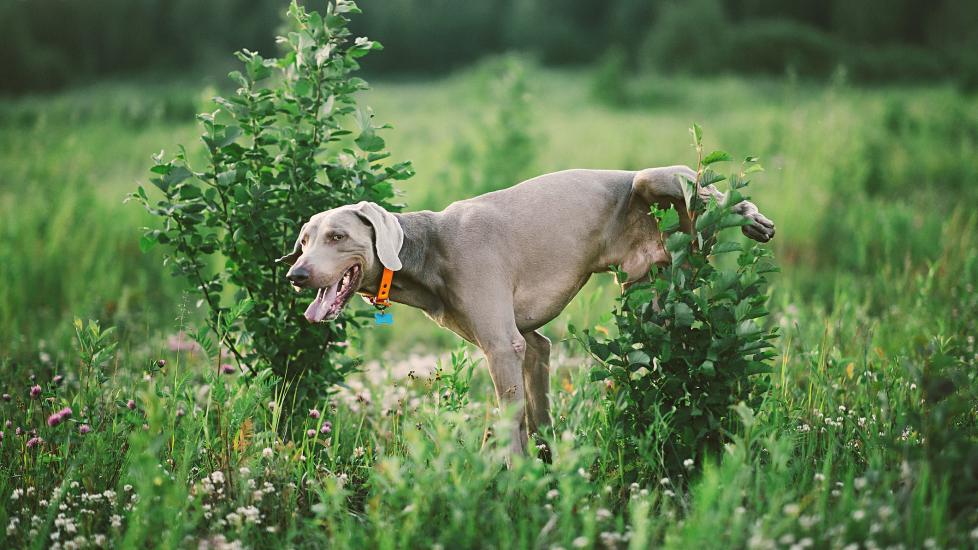12 Dog Peeing Positions and What They Mean
When nature calls, you might expect your dog to use one of two peeing positions: male dogs peeing with a raised leg and female dogs squatting to pee.
However, dogs use all sorts of urination positions. In fact, scientists have categorized what postures dogs take to pee, assigning the 12 dog peeing positions specific names.
Urination postures are more of interest to veterinary behaviorists than those specializing in the urinary tract or other medical issues.
In other words, if your dog has always peed unconventionally and isn't showing signs of discomfort or behavioral changes, there's typically no reason to worry, says Dr. Michael Wood, a member of The American Society of Veterinary Nephrology and Urology and associate professor at the Department of Medical Sciences at the University of Wisconsin-Madison School of Veterinary Medicine.
What Are the 12 Dog Peeing Positions?
What is the normal position for a dog to pee in? Researchers all agree that whatever feels comfortable to your pup is best. Here are 12 elimination positions commonly seen in dogs.
Stand
For the simplest of all dog peeing positions, the dog makes no noticeable adjustments to their standing posture when urinating.
Lean
Also known as the juvenile lean posture or the racehorse stance, the lean is the go-to peeing stance for most young male pups. Both hind limbs stay on the ground, the body leans forward, and the hind legs are extended back.
So when can you expect your male dog to outgrow the lean position and begin lifting their leg? That depends on their breed and can take six months to more than a year.
Flex
In this position, the hind legs are partially flexed so the rear end dips but isn't too close to the ground. The hind feet are positioned under the body rather than out to the side in a straddling position. The spine is straight or bowed upward.
Squat
A female dog’s most common peeing position, which is uncommon but not unheard of in male dogs, is called the squat. In this position, the dog bends both hind legs and straddles, bringing the rear end close to the ground and directing the urine stream downward.
Handstand
This is no doubt the silliest sounding (and silliest looking) dog peeing position of them all: both hind feet are lifted off the ground in this doggie urination stance. Talented pups may balance only on their front paws with their back limbs unsupported, while others may place one or both hind legs against a vertical surface for support.
Arch
When a dog uses the arch position, they will spread and bend their hind legs so that their rear end is toward the ground. Their back is arched, and the pup lifts their tail up.
Raise
A common peeing position for many male dogs, the raise position means one back leg is raised at or below hip level. It allows pups to eliminate and mark their territory. Researchers say about half of dogs are ambilateral, meaning they have no preference for which leg they raise when peeing.
Elevate
One hind leg is bent and raised off the ground. Unlike the raise position, the elevated leg is raised above the hip, with a slight rotation of the pelvis. Only 2% of female dog urinations—compared to 97% of urinations in male dogs—are in the elevate position, according to one study from the 1970s.
Variant positions, or combos of the above, allow pups to walk while urinating or defecating.
Lean-Raise
This position is a mixture of the lean and raise positions.
Flex-Raise
The flex-raise position is a mixture of the flex and raise positions in dogs.
Squat-Raise
A combination of a squat and a leg lift is usually observed in female dogs when they are outside of their home territory.
Arch-Raise
A combination of the arch and raise postures. Like squat-raise, this posture is most often seen in female dogs when they’re marking territory away from their home range.
Vet Recommended Health Support
- Nutramax Imuquin Immune Support Powder Immune Supplement for Dogs, 30 count$24.99Chewy Price
- Purina Pro Plan Veterinary Diets FortiFlora Powder Probiotic Digestive Supplement for Dogs, 30 count$30.99Chewy Price
- Purina Pro Plan Adult Sensitive Skin & Stomach Salmon & Rice Formula Dry Dog Food, 16-lb bag$54.48Chewy Price
- Virbac Epi-Otic Advanced Ear Cleaner for Dogs & Cats, 4-fl oz bottle$12.34Chewy Price
Difference in Peeing Positions for Male and Female Dogs
Which peeing position your dog takes largely varies by their age and gender. Here are some common differences in male and female urination beyond their anatomy:
-
Generally, female dogs are more creative in how they go, practicing a wider range of peeing positions than males.
-
Male dogs usually pee in an elevated position, while female dogs usually squat or squat-raise to pee.
-
Male dogs tend to mark their territory by peeing on objects that other male dogs have peed on, smelling objects before and while urinating. Female dogs tend to sniff the area before peeing but may not select a spot to urinate based on other dogs’ urination.
-
Female dogs empty their bladders all at once, while male dogs may pee in small amounts multiple times. If your male dog squats to pee, he may simply be taking a more efficient approach to emptying his bladder.
Ultimately, there’s no one “normal” position for your male or female dog to be in when urinating.
However, if you notice that your dog has taken a new peeing position and is straining to pee, is peeing more often than usual, or displays other changes in behavior, see your veterinarian for a checkup.
They might also have a few favorite positions or choose a combo stance that allows them to walk while doing their business.
What position your dog chooses may also depend on their age, since puppies tend to lean while senior dogs are less likely to balance on their front limbs.
However, if you notice that your dog has taken a new peeing position and is straining to pee, is peeing more often than usual, or displays other changes in behavior, see your veterinarian for a checkup.
When Do Male Puppies Start Lifting Their Legs to Pee?
As a male dog starts to reach maturity, he will increasingly lift his leg while urinating.
Male puppies are sexually mature at different times, based on their size when they reach adulthood.
Small dogs are around 6 months of age, 9 months in medium to large breeds, and giant-breed dogs can be over a year old.
Why Do Males Lift Their Legs, and Why Do Females Squat?
Dogs urinate to get rid of waste and to mark their territory. Male dogs mark more often than female dogs, which is why male dogs lift their legs, urinating small amounts on many vertical surfaces.
On the other hand, peeing positions such as the squat direct the urine stream downward rather than up and at an object. The position allows dogs to empty their bladders quickly and completely.
Male dogs aren’t the only ones using a urination posture that allows them to mark, and some male dogs squat to pee. Small dogs of both sexes are more likely to pee standing with a leg raised than large dogs.
There’s also evidence that the raise position may be related to the confidence level of the dog.
“With each additional day spent at the shelter, the odds of a male having a predominant urinary posture with a raised hindlimb increased by 2% … suggests that male urinary posture could potentially serve as a behavioral indicator of adjustment to shelter conditions,” one study reports.
12 Dog Peeing Positions FAQs
Why is my dog squatting but not peeing?
If you notice your dog is squatting and no urine is coming out, this should be treated as a serious medical concern.
This can be an indication of a urinary tract infection or a urinary obstruction.
A urinary obstruction occurs when something physically blocks a dog’s ability to urinate, such as inflammation, stones, or crystals.
If your dog is squatting and nothing comes out, they should see their veterinarian for an exam to rule out a medical emergency.
What is submissive peeing in dogs?
Submissive urination occurs when a dog that normally doesn’t have accidents in the house will posture and urinate when they feel fearful. They will often crouch down low with their head down and their ears back.
Featured Image: Aleksandr Zotov/iStock / Getty Images Plus via Getty Images




